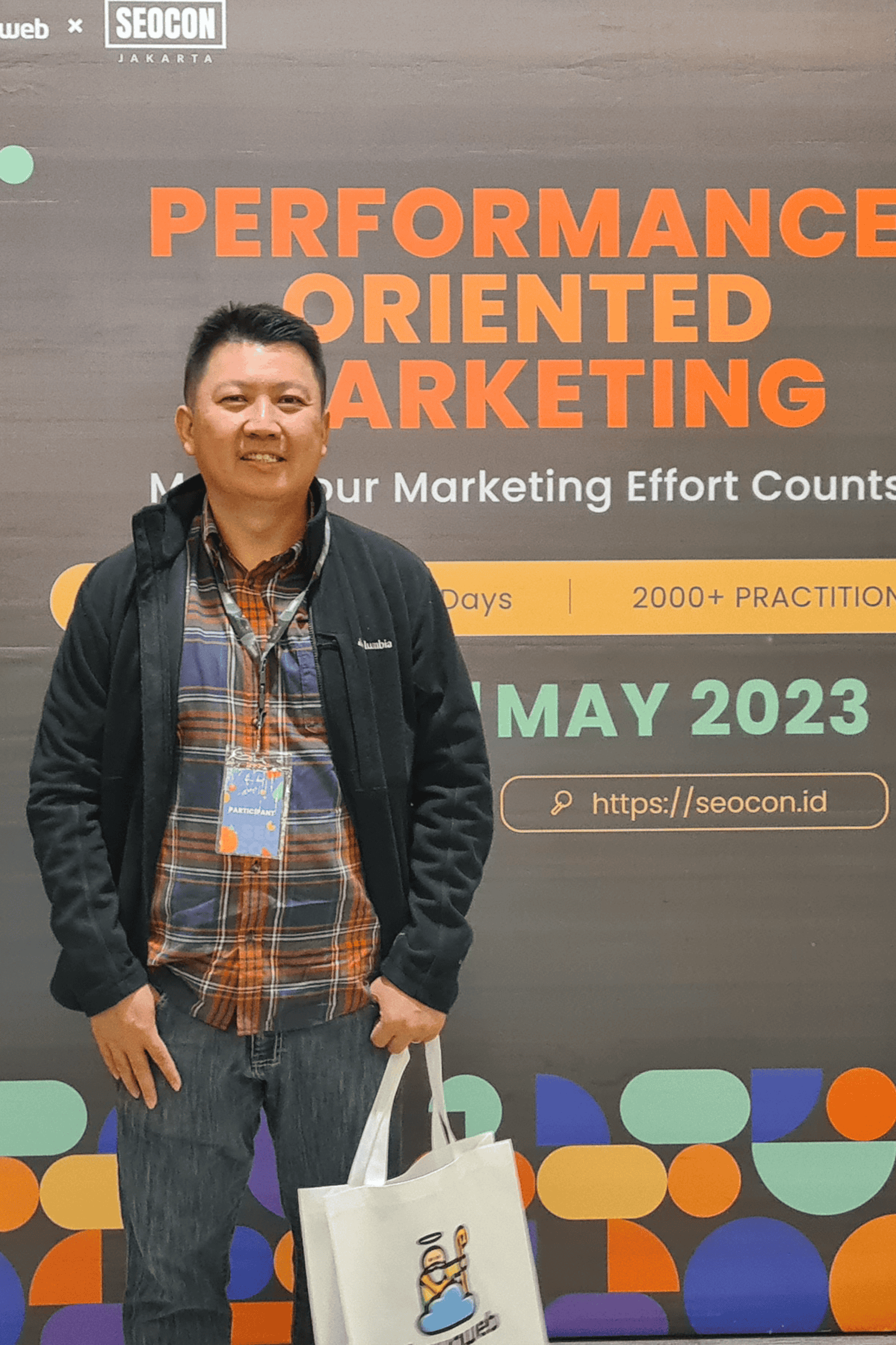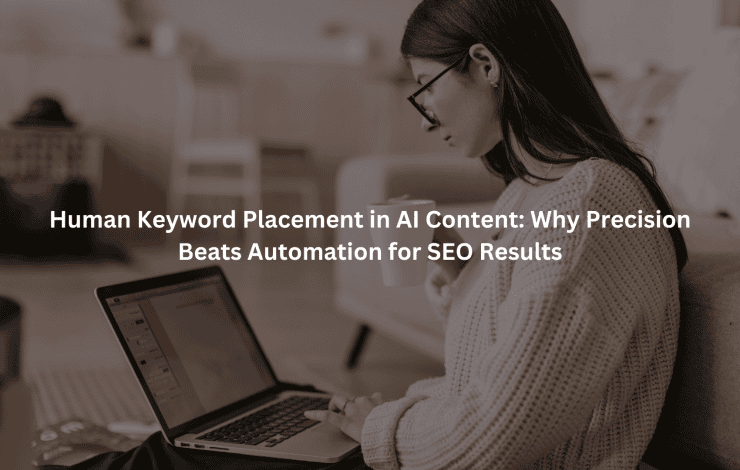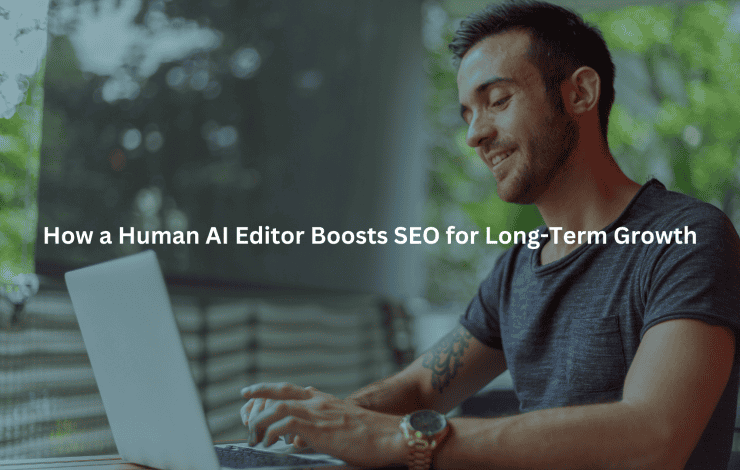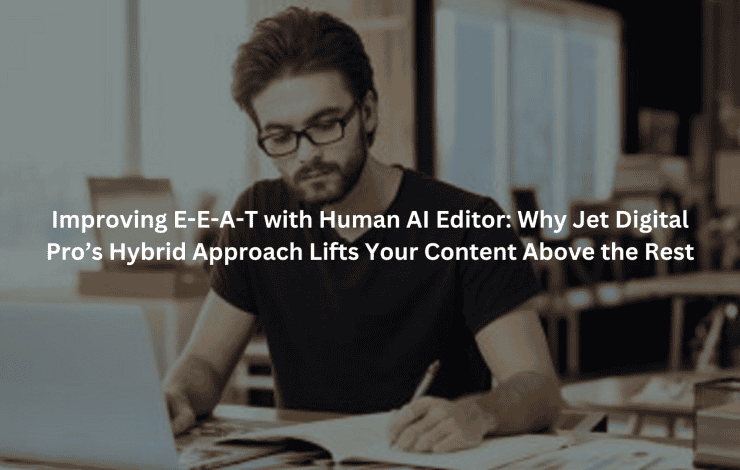The first time We watched an agency team and an AI tool try to align on on-page SEO, it felt a little like watching two people play chess across different boards. The AI would shoot out keyword suggestions and technical tweaks at lightning speed.
Meanwhile, the editorial team would circle back, slowing things down to rephrase a sentence or swap out a keyword that read awkwardly. Neither could win alone. The answer, We learned, is not picking sides but learning how humans and AI can merge their strengths, especially when the goal is content that ranks, reads naturally, and fits a brand’s voice.
Jet Digital Pro saw this early. We built our entire process around making these two forces complement each other, AI for raw speed and scale, humans for context, nuance, and the kind of judgment you just don’t get from a machine.
This article takes apart the human AI editor for on-page SEO: how the tasks split, where each shines, and why this hybrid model is now the gold standard for agencies and businesses wanting to grow organic traffic without letting quality slide.
Key Takeaways
- Combining AI-driven suggestions with human editorial oversight is now essential for SEO content that ranks, reads well, and supports brand strategy.
- Jet Digital Pro’s approach, AI for analysis and automation, human editors for polish, lets agencies scale content without sacrificing quality or context.
- The best results come from a workflow where AI tackles data-heavy tasks, humans refine and validate, and both sides work in real time to adapt to Google’s ever-changing algorithms.
Key Responsibilities and Task Division
A human AI editor for on-page SEO is not one person but a process, a relay race where AI and humans pass the baton at each stage. It starts with AI-driven audits and keyword research, then swings over to human editors for context checks, tone adjustment, and strategic choices.
Here’s how we divide it at Jet Digital Pro:
- AI:
- Scans SERPs for keyword gaps, analyzes competitor content, flags technical issues (think meta tags, schema, internal linking).
- Generates outlines, initial drafts, and suggests meta tags or headers.
- Monitors rank changes, detects sudden drops, and pulls performance data.
- Humans:
- Validate which keywords actually fit the client’s goals and audience.
- Add nuance, context, and brand voice to AI-generated drafts.
- Review technical fixes to ensure they support user experience as well as SEO.
- Adjust and interpret data, pivoting strategies as needed.
It’s a workflow that keeps both speed and quality in play, with humans making the final call on anything that shows up for searchers.
Keyword and Competitor Analysis
AI, frankly, is better at sifting through millions of search results than any human could be. At Jet Digital Pro, we use AI-driven keyword research tools to:
- Scan top-ranking pages for target terms, semantic keywords, and related phrases.
- Map out what competitors are ranking for and where the content gaps are.
- Pull search volumes, keyword difficulty scores, and keyword variations, fast.
But raw data isn’t strategy. The human editors step in to:
- Decide which keyword opportunities are relevant to business goals, audience intent, and current content themes.
- Spot trends that AI might miss, like sudden shifts in topical authority or new long-tail keyword clusters.
- Avoid keyword cannibalization by mapping keywords to the right pages and themes.
This two-pronged approach means coverage is broad and deep, with every keyword chosen for both search engine ranking potential and real user engagement. [1]
AI-Driven Keyword Suggestions and SERP Scanning
There’s an art to reading a SERP. AI tools can scan thousands of search results, picking out:
- The most repeated semantic keywords.
- Related questions and entities.
- Patterns in meta tags, internal links, and content structure.
Jet Digital Pro’s workflow has AI pull all this together into keyword lists, thematic clusters, and even headline ideas. But before anything gets published, humans check for:
- Outdated or irrelevant suggestions.
- Overlap with existing site content.
- Contextual fit with current campaigns or seasonal trends.
That way, the content isn’t just optimized for Google’s algorithm but also for the shifting sands of user intent and business priorities. [2]
Human Validation and Contextual Additions
Machines can spot patterns, but they don’t know your clients’ inside jokes, regional quirks, or the difference between being helpful and being pushy. This is where human editors step in, especially at Jet Digital Pro. We:
- Adjust AI-suggested keywords for tone and intent.
- Add context, stories, or examples to make content more relatable.
- Double-check semantic relevance, so “keyword density” doesn’t turn into keyword stuffing.
- Ensure every keyword serves a purpose in the narrative, not just the search engine.
Personal anecdote: We once had an AI recommend “best cheap legal advice” for a client’s legal blog. Makes sense for traffic, but the client’s brand was “premium, trusted, not bargain bin.” Human judgment kept the message consistent and the audience engaged.
Content Drafting and Editing
First drafts are where AI shines, speed, structure, and even basic coherence. Jet Digital Pro’s system can generate entire article drafts, meta descriptions, and even suggested internal links in minutes.
Still, AI-written drafts rarely get published as is. Human editors:
- Tighten up paragraphs, cut fluff, smooth awkward transitions.
- Fix technical SEO elements, headings, alt text, schema.
- Insert brand voice and local flavor.
- Add supporting keywords, clarify user intent, and ensure every section has a point.
It’s like having a sous chef prep the ingredients, but the head chef finishes the dish.
AI-Generated Outlines and Meta Tags
AI tools can spit out outlines and meta tags based on the top ten results for a keyword, often in under a minute. At Jet Digital Pro, we use this feature to:
- Speed up the planning phase, no more blank page paralysis.
- Ensure every article covers the necessary semantic topics for SEO relevance.
- Optimize for both primary and secondary keywords in headers and meta data.
But the human touch is what keeps these outlines from feeling mechanical:
- Reordering sections for better flow.
- Adding or removing topics based on audience feedback or brand guidelines.
- Tweaking meta tags to improve CTR without resorting to clickbait.
Human Refinement for Tone, Clarity, and Brand Voice
Even the smartest AI can’t write like a real person with a stake in the outcome. This is where human editors earn their keep:
- Shaping the draft so it matches the client’s tone, whether that’s conversational, technical, or authoritative.
- Fixing clarity issues (AI sometimes gets lost in jargon or circular logic).
- Ensuring every piece of content feels like it was written by someone who actually cares about the reader’s experience.
At Jet Digital Pro, we use an 11-step human editing process for this. It’s a grind, but it’s how you get content that’s both search-optimized and genuinely useful.
On-Page Optimization and Technical SEO

AI can scan a page for missing meta tags, slow-loading images, broken schema, and all kinds of technical issues. It can fix a lot of them too, automatically inserting alt text, tweaking internal links, or compressing images.
But machines don’t always get nuance. Human editors:
- Check that technical fixes don’t mess up design or UX.
- Ensure schema markup matches the page’s actual content (not just what the AI “thinks” is relevant).
- Review all changes for compliance with Google’s latest algorithm updates.
This back-and-forth keeps the site running smoothly and ranking high.
Automated Keyword Insertion and Technical Fixes
AI tools can automate keyword insertion, dropping target phrases, supporting keywords, and internal links into drafts. This boosts thematic relevance and helps with topical authority.
Still, there’s risk. Over-automation can lead to:
- Keyword stuffing.
- Awkward phrasing.
- Broken natural flow.
At Jet Digital Pro, human editors always review final drafts for keyword density, placement, and readability. No keyword gets left hanging, and no sentence gets mangled for the sake of SEO.
Human Review for Readability and Best Practices Compliance
AI can check for grammar, spelling, and even sentence structure. But it doesn’t know when a joke falls flat or a call-to-action feels forced.
That’s why every piece of content at Jet Digital Pro gets a human pass for:
- Readability and engagement.
- Alignment with E-E-A-T (Experience, Expertise, Authoritativeness, Trustworthiness).
- Compliance with internal editorial and brand standards.
AI is a tool. Humans make sure the tool doesn’t shape the message more than the message shapes the tool.
Performance Tracking and Strategy Adjustment
Once the content is live, the work doesn’t stop. AI tools can monitor:
- Rankings for target and long-tail keywords.
- Changes in organic traffic, bounce rates, and user engagement.
- Technical issues that might pop up over time.
But interpreting these numbers is a human job. At Jet Digital Pro, we:
- Dig into why a page might be dropping in the rankings (algorithm update, new competitor, search intent shift).
- Adjust on-page SEO strategy based on real performance, not just what the tools suggest.
- Communicate insights back to the client in plain English, with real recommendations.
AI Monitoring of Rankings and Issue Detection
AI is relentless and tireless, which makes it perfect for:
- Tracking keyword rankings daily (or even hourly).
- Flagging sudden drops or spikes in traffic.
- Detecting technical SEO issues before they become big problems.
Are You a Digital Agency?
White Label SEO Content Services for Agencies
Scalable, customizable, and results-driven content solutions for your clients.
Human editors use these alerts as jumping-off points for deeper investigation, strategy tweaks, or emergency fixes.
Human Interpretation and Strategic Response
A ranking drop doesn’t always mean the content is bad. Maybe Google tweaked its algorithm, maybe a competitor just published something huge, or maybe the search intent shifted. Human editors at Jet Digital Pro:
- Analyze the data in context.
- Decide whether to update the content, build new links, or pivot the keyword targeting.
- Keep the strategy nimble and responsive, not just reactive.
Advantages of Integrating Human AI Editors
What’s the real upside to this hybrid approach? A few things stand out.
- Efficiency Gains: AI automates repetitive stuff, keyword research, technical fixes, draft generation, freeing up editors to focus on strategy and creativity.
- Quality Assurance: Human editors ensure every piece meets editorial and brand standards, never reading like it was churned out by a machine.
- Adaptability: AI tools adapt quickly to Google’s algorithm changes. Humans interpret those changes and adjust strategy before competitors catch up.
- Scalability: With AI handling the grunt work, agencies can take on bigger projects without losing quality control.
Tools Facilitating Human AI Collaboration in SEO

A few tools have made this workflow easier for agencies and digital marketers.
- On-Page.ai: Real-time content editor, auto-optimization, keyword/entity suggestions. Great for fast feedback and team projects.
- Surfer SEO: Collaborative editor, NLP keyword integration, real-time feedback for multi-user teams.
- Alli AI: Automates technical and on-page fixes, but always requires a human green light before publishing changes.
- AI Writing Tools (like ChatGPT): Drafts content, meta tags, and more, but always needs a final human review for polish and accuracy.
At Jet Digital Pro, we’ve tested these tools and blended the best features into our workflow, always keeping human oversight as the final filter.
FAQ
How does a human AI editor reduce keyword cannibalization across multiple pages?
When several pages target the same keyword phrases, it confuses search engines and damages search engine ranking. A human AI editor helps fix that through careful keyword mapping and keyword analysis.
They review content structure, keyword usage, and content themes to reduce overlap. This improves topical authority and keyword relevance. Using keyword clustering, keyword segmentation, and contextual keywords, they guide each page toward a specific user intent and target keyword set. That improves search visibility and reduces internal competition.
Can human AI editors improve semantic keyword usage better than automated SEO tools?
Most automated SEO tools suggest related keywords and LSI tools based on keyword trends or search volume. But they can’t always judge thematic relevance or keyword intent. A human AI editor uses semantic analysis to improve content relevance, integrating keyword variations and supporting keywords with more nuance.
They avoid keyword stuffing while strengthening latent semantic indexing. That helps with search relevance and organic traffic since content quality and content optimization align more directly with user engagement and Google algorithm expectations.
What role does a human AI editor play in fixing low-performing pages with poor keyword targeting?
A human AI editor uses keyword research tools, competitor analysis, and content audit reports to find what went wrong. They fix poor keyword placement, enrich content with targeted keywords, and adjust keyword density to reflect actual keyword performance.
Need a Strategic SEO Content Partner?
Let’s craft SEO content that ranks, converts, and grows your brand.
Talk to UsOften, the problem is either missing secondary keywords, unclear user intent, or outdated keyword trends. Editors refresh content topics and keyword opportunities based on semantic relevance and content freshness. Over time, that boosts search engine ranking and increases traffic generation.
How does keyword proximity and placement change under a human-AI editing process?
Human AI editors don’t just plug in keyword suggestions from a keyword planner, they look at keyword proximity in the sentence and paragraph. Poor placement can confuse search engines even if the right keywords are there. Editors rework keyword integration so primary, secondary, and supporting keywords flow together naturally.
This improves SEO optimization without sacrificing readability. That kind of keyword enrichment also boosts website ranking and improves conversion rate by aligning content themes with the actual user’s search terms.
Why is keyword clustering better handled by a human-AI hybrid than full automation?
Automated keyword clustering often groups similar keywords based on broad search volume or keyword difficulty. But those clusters miss subtle keyword intent differences or ignore content structure. Human AI editors use semantic search insights and manual keyword analysis to build more accurate clusters.
They match keyword variation with content topics and keyword relevance to avoid overlap. That precision boosts organic traffic, supports SEO content strategy, and strengthens keyword targeting without wasting space or repeating the same search terms.
Conclusion
If you’re running SEO for an agency or business, split the workload. Let AI handle keyword research and draft generation. Then use experienced editors to refine content, validate keyword targeting, and align it with your brand voice.
JetDigitalPro does this at scale, combining AI speed with an 11-step human editing system built for agencies. No fluff, just measurable content results delivered consistently.
Ready to scale without guesswork? Contact JetDigitalPro to get started.
References
- https://seranking.com/blog/competitor-keyword-analysis/#:~:text=Competitive%20keyword%20analysis%20is%20a,ultimately%20secure%20higher%2Dquality%20traffic.
- https://neilpatel.com/blog/ai-keyword-research/
Related Articles
- https://jetdigitalpro.com/how-human-ai-editor-boosts-seo/
- https://jetdigitalpro.com/human-ai-editor-for-seo-optimization/
- https://jetdigitalpro.com/role-and-value-of-human-ai-content-editors/
P.S – Whenever you’re ready,
we’re here to help elevate your SEO content.
Partner with us for strategic, scalable content that drives real organic growth.
Contact Us Now




